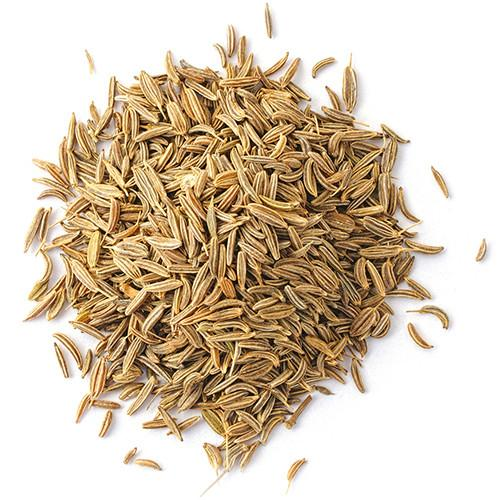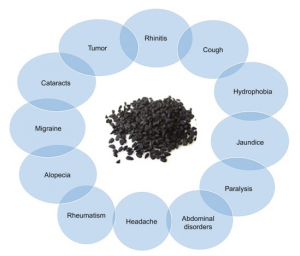
Cumin seeds (Cuminum cyminum) locally known as ‘zeera’ are obtained from the herb Cuminum cyminum, native from East Mediterranean to South Asia belonging to the family Apiaceae—a member of the parsley family. Cumin seeds are oblong and yellow–grey. Cumin seeds are liberally used in several cuisines of many different food cultures since ancient times, in both whole and ground forms. In India, cumin seeds have been used for thousands of years as a traditional ingredient of innumerable dishes including kormas and soups and also form an ingredient of several other spice blends. Besides food use, it has also many applications in traditional medicine. In the Ayurveda system of medicine in India, cumin seeds have immense medicinal value, particularly for digestive disorders. They are used in chronic diarrhea and dyspepsia. Black seed (also known as black cumin; Nigella sativa) is an annual flowering plant belonging to the family Ranunculaceae and is a native of Southern Europe, North Africa, and Southwest Asia. Black cumin is cultivated in the Middle Eastern Mediterranean region, Southern Europe, Northern India, Pakistan, Syria, Turkey, Iran, and Saudi Arabia. Nigella sativa seeds and their oil have a long history of folklore usage in Indian and Arabian civilization as food and medicine
Different types of cumin
- Cumin ( Cuminum cyminum ): called green cumin in Iran, is a small 15-50 cm high gramineous plant with long and thin roots, very thin leaves, and white or pink flowers. This plant is native to Egypt and Nile shores.
- Caraway (Carum carrvi): Cumin is often confused with caraway (Carum carvi L.), another Umbelliferous spice, because of the nearly similar size, odor and especially culinary and medical uses of the two spices. Some European languages even do not distinguish clearly between the two. However, there are many marked differences between them. Cumin is lighter in color, hotter in taste and larger than caraway. Some older cookbooks erroneously name ground coriander as cumin. The distantly related Bunium persicum and the unrelated Nigella sativa are both sometimes called black cumin. In Iran, a clear distinction is made between these four species with their different size, color and tasts. Cumin, also called ‘zireh sabz’, is yellowish-green, narrowly boat shape, a little sweet and mild in taste and odor. Caraway, also called ‘zireh siyah’, is light black, a little fl attened with pungent taste and odor. Bunium persicum, also called ‘zireh kuhi’, ‘zireh kermani’ or ‘zireh siyah’, is black, narrowly curved and very pungent in taste and odor. Nigella sativa, also called ‘siyah daneh or shuniz’, is black, irregular prismatic in shape and has a mild odor and pungent – bitter taste.
- Black Cumin ( Nigella/kalonji ): is a two-year 30-60 cm high plant having empty stems and thin light green leaves. it is native to limited area of west Asia including the eastern regions of Iran
- Bitter Cumin ( Kashmiri Jeera / Shahi jeera )
- Some additional names for black seed oil include: black caraway,black cumin
- black onion seed,kalonji
The two major types of cumin seeds found in the market are white cumin seeds and the black cumin seeds. The white cumin seeds are the most commonly are used in cuisines. However, the black cumin seeds are smaller in shape than the white one and also have a sweet aroma.
Also, Cumin powder, or ground cumin, is the ground version of whole cumin seeds. The main difference between whole cumin seeds and ground cumin is the way they are used in recipes.

| Common name of the spice | Cumin | Caraway | Black cumin (Nigella/kalonji) | Bitter cumin (Kashmiri jeera/ Shahi jeera) |
| Scientific name | Cuminum cyminum | Nigella sativa | Cuminum nigrum or Bunium persicum | |
| Genus/family | Cuminum/Apiaceae (member of Parsley family) | Nigella/Ranunculaceae | Cuminum/Apiaceae | |
| Native of countries growing | East Mediterranean to South Asia. Now mostly grown in Pakistan, India, Uzbekistan Iran, Turkey, Morocco, Egypt, Syria, Chile, Mexico, and China |
South to Southwest Asia. Middle Eastern Mediterranean region, South Europe, Northern India, Pakistan, Syria, Turkey, Iran, and Saudi Arabia | Central Asia to Northern India. Mountainous regions of North India | |
| Traditional uses | Both whole and ground seeds are used in the cuisines of many cultures for ages. It has also many uses in traditional medicine. They are used in chronic diarrhea and dyspepsia | A spice in Indian and Middle Eastern cuisines. In the ancient Egypt, it was used as a preservative in mummification. Traditionally, it is used for asthma, diabetes, hypertension, fever, inflammation, bronchitis, dizziness, eczema, and gastrointestinal disturbances | A spice in Northern Indian cookery, often the Moghul cooking | |
| Main constituents | Cuminaldehyde | Thymoquinone | Cuminaldehyde, p-mentha-1,3-dien-7-al and p-mentha-1,4-dien-7-al |
Benefits
Cumin:
Loaded with nutrients:
Cumin seeds are nutritionally rich; they provide high amounts of fat (especially monounsaturated fat), protein, and dietary fiber. Vitamins B and E and several dietary minerals, especially iron, Just one teaspoon of cumin seeds contains around 2mg of your daily iron intake (that’s 14% of daily iron intake for women and 23% for men) are also considerable in cumin seeds Cumin is known for its antioxidant properties. The most important chemical component of cumin fruits is essential oil content, ranging from 2.5% to 4.5% which is pale to colorless depending on age and regional variations. Studies of the chemical composition of cumin oil from different countries showed the presence of the following components: α-pinene (0.5%), Myrcene (0.3%), limonene (0.5%), 1-8-cineole (0.2%), p-menth-3-en-7- ol (0.7%), p-mentha-1, 3-dien-7-ol (5.6%), caryophyllene (0.8%), β-bisabolene (0.9%), β-pinene (13.0%), P-cymene (8.5%), β-phellandrene (0.3%), D-terpinene (29.5%), cuminic aldehyde (32.4%), cuminyl alcohol (2.8%), β-farnesene (1.1%) together with much smaller quantities of α-phellandrene, αterpinene, cis and trans sabinene, Myrtenol, α-terpineol and phellandral. In addition to volatile oil cumin also contains nonvolatile chemical components including tannins, oleoresin, mucilage, gum, protein compounds and malate. The total phenolic content of methanolic extracts of different cumin varieties (cumin, black cumin and bitter cumin) ranged from 4.1 to 53.6 mg/g dry weight.
Health effects of Cumin:
Although the seeds of cumin (C. cyminum L.) are widely used as the spice for their distinctive aroma, they are also commonly used in traditional medicine to treat a variety of diseases, including chronic
diarrhea and dyspepsia, acute gastritis, diabetes, and cancer. The literature presents ample evidence for the biological and biomedical activities of cumin, which have generally been ascribed to its bioactive constituents such as terpenes, phenols, and flavonoids. Those health effects of cumin seeds that are experimentally validated are discussed below.
- Digestive stimulant action
- Antidiabetic effects
- Anti-inflammatory effects
- Cardio-protective influence through hypolipidemic and hypotensive effects
- Chemo preventive effects
- Miscellaneous nutraceutical effects
Cumin and Lose Weight:
Cumin may boost your metabolism, lower cholesterol level, and help decrease your blood sugar. Studies confirm that consuming ground cumin helps some people who are trying to losing weight.
While there’s no guarantee that cumin will jump-start your weight loss, its unique properties and other health benefits make it worth a try for most people.
Health effects of Nigella sativa
Nigella sativa is a flowering plant that’s also called: fennel flower, black caraway, kalonji
It’s native to parts of: Asia, the Middle East, North Africa.
Black cumin (N. sativa) has been in use in traditional systems of medicine for various medical disorders. Nigella sativa is used in Moroccan folk medicine for the treatment of diabetes mellitus.
Many pre-clinical and clinical trials have investigated its efficacy, using the seed oil, essential oil, and its isolated main constituent TQ.
- Antidiabetic effects
- Ameliorative effects of N. sativa on dyslipidemia
- Anti-inflammatory property and analgesic activity
- Immunomodulatory action
- Antioxidant and antimicrobial activity
- Anti-cancer properties
- Gastroprotective effect
- Nephroprotective effect
- Hepatoprotective effect
- Pulmonary-protective activity and anti-asthmatic effects
- Miscellaneous nutraceutical effects
Quality specifications
Seeds are oblong in shape, thicker in the middle, compressed laterally, about 3–6 mm Long, resembling caraway seeds, but lighter in color and bristly instead of smooth, almost straight instead of being curved. They have nine fine ridges, overlapping as many oil channels, or vita. The odor and taste are somewhat like caraway, but less agreeable. Specific quality indices are:
- seed moisture: less than 6 %
- total ash: 7 %
- acid insoluble ash: 1.5 %
- volatile oil: minimum 2 %
- foreign organic matter: 2 % (US maximum for harmless foreign matter:5 %)
Cooking
Cumin seed is an ancient spice with a strong aromatic smell and warm, bitter taste.
In Biblical times, cumin seeds were valued for their digestive properties and were used for flavoring bread and other dishes during the periods of ceremonial fasting, to make up for the lack of meat. Ground cumin is most popular in countries and regions in which the food is generally highly spiced, such as India, Iran and other parts of the Middle East, Mexico and North Africa. It is an essential ingredient in most Indian curry powders and garam masala.
Cumin is used in both meat and vegetable dishes, as well as in soups and sauces. A popular Indian recipe is jeera rice, which is a combination of rice and cumin seeds. Cumin is also a seasoning in Middle Eastern falafel and also can be found in some cheeses, such as Leyden cheese, and in some traditional breads from France. Depending on whether the recipe calls for cumin seed or ground cumin, you will use it differently in recipes. Whole cumin seeds should be included early in the recipe so the spice has time to release its essence; adding them to a hot broth or oil will allow the aroma and flavors to disperse into the dish. Ground cumin is a quintessential spice in a few different blends, including curry powder. It is also used as part of a rub, in a marinade, and as a seasoning for hearty dishes. If switching from whole seeds to ground (or vice versa), you will need to add different amounts. Because the flavor of ground cumin is more concentrated than whole cumin seeds, you will need less in a dish. For a recipe that calls for 1 tablespoon of ground cumin, use 1 and 1/4 tablespoons of cumin seeds.
Although cumin is more commonly used to season savory dishes, people can use this healthful spice in sweet recipes, as well.
For example, the smoky flavor of cumin pairs well with chocolate and can work in chocolatey recipes including mousse, fudge, and cakes. People can also mix cumin with other tasty spices, such as cinnamon and cloves, to give an interesting kick to fruity desserts such as baked apples or pears.
Also, don’t be afraid to experiment with cumin when making desserts. That said, since cumin has a strong flavor, start slow and only add small amounts to avoid going overboard.
producer of cumin
India is the world’s largest cumin producing country, contributing about 70% of total world output. The other major cumin-producing countries are Syria (13%), Turkey (5%), UAE (3%), and Iran .In 2019, the top exporters of Cumin seeds were India ($462M), Syria ($36.8M), Turkey ($26.1M), United Arab Emirates ($19.5M), and Iran ($10.6M). In 2019, the top importers of Cumin seeds were China ($106M), Bangladesh ($59.2M), United States ($45.5M), Afghanistan ($26.4M), and Egypt ($22.6M)
Imports: In 2019 the top importers of Cumin seeds were China ($106M), Bangladesh ($59.2M), United States ($45.5M), Afghanistan ($26.4M), and Egypt ($22.6M).




